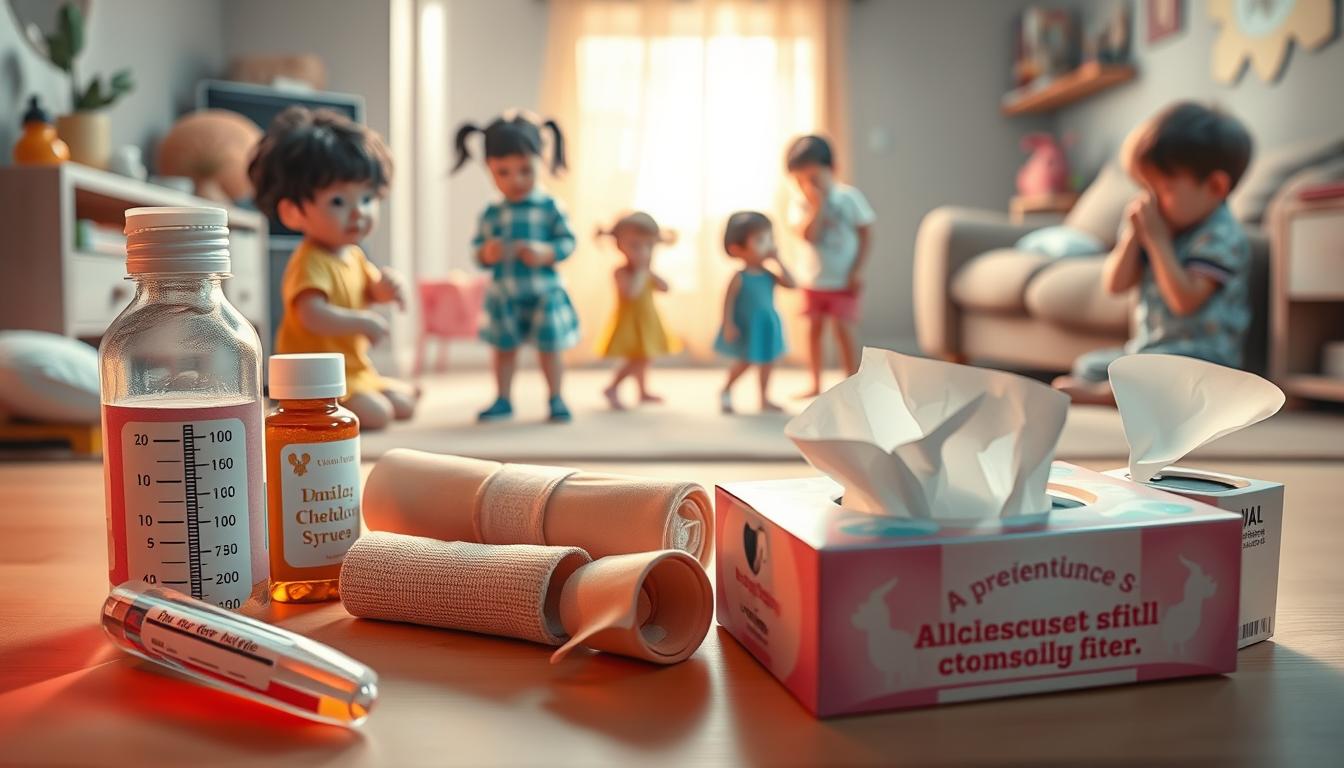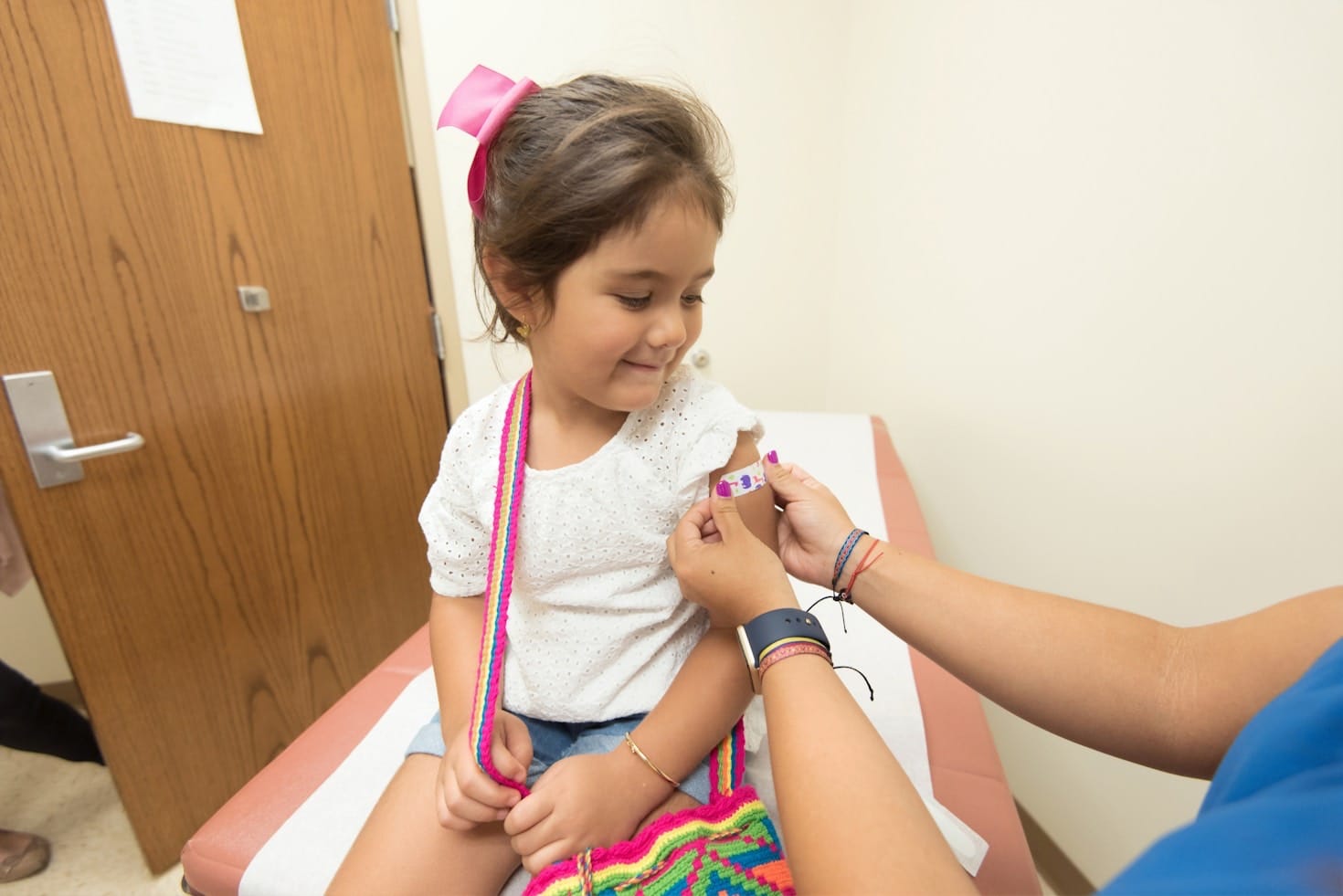How to Prevent Common Childhood Illnesses

You want to know how to keep your child from getting sick. This guide shows you simple steps to take at home, school, and daycare. These actions help lower risks and stop illnesses from spreading.
We talk about many common childhood illnesses. This includes diseases like measles and mumps, and infections like strep throat. You’ll learn tips that work for many conditions.
For the latest information, check the Centers for Disease Control and Prevention (CDC) and the American Academy of Pediatrics (AAP). Also, visit your state health department for local alerts. These places offer the best advice on preventing childhood illnesses.
This article gives you practical tips. You’ll learn about recognizing symptoms, vaccinations, and handwashing. It also covers nutrition, sleep, and keeping your home clean. Follow these steps to keep your family healthy.
This guide is for parents and caregivers in the United States. It’s written for you. By following this advice, you can protect your child’s health and feel more confident.
Common childhood illnesses and How to prevent them

Children face many infections as they grow. Knowing the usual ones and how to prevent them keeps them healthy. This section covers common childhood illnesses, why prevention is key, and how to use simple tips to reduce risks.
Overview of the most frequent childhood illnesses
Respiratory infections are common. The common cold, influenza, and RSV spread through droplets and touch. Gastrointestinal infections like norovirus and rotavirus cause vomiting and diarrhea.
Bacterial infections include strep throat, ear infections, and urinary tract infections. Vaccine-preventable diseases like measles and mumps are rare but can happen.
Skin problems like impetigo and ringworm spread by contact or shared items. Knowing these patterns helps prevent illnesses with simple steps.
Why prevention matters for long-term children’s health
Preventing illnesses means less school missed and fewer clinic visits. It also means fewer antibiotics used.
Long-term benefits include lower risks of serious complications. Vaccines protect not just the vaccinated but also others through herd immunity.
At a community level, prevention saves money and stops outbreaks. It keeps your family and neighbors safe.
How to use this guide to reduce your child’s risk
Start by learning to recognize symptoms early. Follow vaccination schedules and teach good hygiene habits.
Support your child’s immune system with healthy food and sleep. Work with schools and caregivers to keep everyone healthy.
Keep this guide handy and share it with others. Using these steps helps prevent illnesses in your home and community.
Recognizing symptoms early to limit spread

Spotting illness early keeps your child safer and helps stop germs. Use simple health practices at the first sign of trouble. Keep a thermometer, note changes in behavior, and have your pediatrician’s sick-day guidance handy.
Common warning signs to watch for at home and school
Watch for fever of 100.4°F (38°C) or higher, a persistent cough, or trouble breathing. Look for decreased eating, fewer wet diapers in infants, repeated vomiting or diarrhea, or a rash with fever. Ear pain, sore throat with swollen glands, or red eyes may signal an infection.
At school, notice frequent coughing, visible nasal discharge, or classmates with conjunctivitis or rashes. High irritability, unusual sleepiness, or inconsolable crying in infants are urgent behavioral clues you should not ignore.
When to keep your child home and when to seek care
Keep your child home for fever with behavior change or any temperature above 100.4°F until fever-free for 24 hours without medication, if your child is vomiting or has diarrhea, or when a rash is likely contagious. A severe, uncontrolled cough that prevents participation is a reason to stay home.
Seek same-day pediatric care for suspected strep throat with fever, an ear infection with severe pain, or signs of dehydration after repeated vomiting or diarrhea. Go to urgent care or the emergency room for difficulty breathing, persistent high fever, seizures, severe lethargy, neck stiffness, or any rapidly worsening condition.
How early recognition prevents complications and transmission
Early recognition lets you start supportive care and get antibiotics when needed, lowering the chance of serious outcomes like complications from untreated infections. Quick action limits transmission by enabling isolation, notifying schools and caregivers, and following exclusion guidance that prevents outbreaks.
Practical tips for daily use: keep a reliable home thermometer, save emergency contacts and local urgent care numbers, and review school or daycare policies on exclusion. These tips for kids’ health make it easier to act fast when recognizing childhood illness symptoms.
Vaccination schedules and vaccine-preventable diseases

Keeping up with recommended immunizations is key to preventing childhood illnesses. The CDC routine schedule starts at birth with hepatitis B. It includes important doses at 2, 4, and 6 months for DTaP, Hib, IPV, PCV13, and rotavirus. At 12–15 months, children get MMR, varicella, and hepatitis A.
Preschool boosters and adolescent vaccines include DTaP boosters, HPV starting at 11–12 years, and meningococcal vaccine. Everyone aged 6 months and older should get annual flu shots. If your infant is high risk, ask about RSV monoclonal antibodies or vaccines.
Use an up-to-date immunization record to track dates and catch-up needs. If your child missed a dose, talk with a provider about a catch-up schedule. Staying current at well-child visits makes prevention routine and easier to manage.
Safety monitoring is robust. Vaccines go through clinical trials before approval. After use, systems like VAERS and the Vaccine Safety Datalink track rare adverse events. Large studies show no link between vaccines and autism.
Vaccines cut illness in two ways. They give direct protection and community protection, or herd immunity. This shields infants too young to complete their series and children with weakened immune systems. Real-world data shows dramatic drops in measles, polio, and diphtheria in the United States.
Practical steps include keeping records, attending scheduled well-child visits, and scheduling catch-up doses when needed. Getting annual flu shots for the whole family is also important. These simple actions support preventing common childhood diseases and strengthen broader children’s disease prevention efforts in your community.
Hand hygiene and respiratory etiquette for kids
Teaching simple routines can protect your child and others from common infections. Focus on clear habits that fit daily life. Short, consistent lessons make hand hygiene and respiratory etiquette for kids easy to remember.
Proper handwashing steps and fun ways to teach children
Show your child how to wet hands with running water, apply soap, lather for at least 20 seconds, scrub backs of hands, between fingers and under nails, rinse, and dry with a clean towel. Supervise young children until they can follow the steps reliably, typically around age 6–8.
Use songs, colorful timers, and sticker charts to make hand hygiene a game. Try kid-friendly soaps from brands like Dove Kids or Cetaphil Baby for sensitive skin. Demonstrate with glitter or glow-in-the-dark lotion so they can see how washing removes “germs.”
Teaching kids cough and sneeze etiquette
Teach children to cough or sneeze into their elbow or a tissue, discard the tissue, and wash hands right away. Model the behavior yourself and ask caregivers at daycare or school to reinforce it.
Practice short drills so kids learn to cover up without panic. Praise consistent effort and give gentle reminders when needed. Strong respiratory etiquette for kids reduces droplet spread and supports overall children’s health tips.
Sanitizers, wipes, and when soap is best
Keep hand sanitizer with at least 60% alcohol for times when soap and water aren’t available. Supervise younger children to prevent ingestion. Use soap and water when hands are visibly dirty, after bathroom use, diaper changes, and before meals.
Carry travel-sized sanitizer and tissues when you go out. Use EPA-registered disinfectant wipes on high-touch shared items when washing isn’t feasible. These small practices support preventing common childhood diseases by cutting transmission paths.
Nutrition, sleep, and immune support
Good nutrition, steady sleep, and immune support are key to keeping your child healthy. Simple changes at meals and bedtime can help. These tips fit into busy family life and protect your child’s health.
Key nutrients that strengthen defenses
Focus on a balanced plate with vitamin C, vitamin D, zinc, protein, and iron. Citrus fruits and strawberries are rich in vitamin C. Fortified milk, sunlight, and supplements provide vitamin D.
Lean meats, beans, and whole grains give zinc and iron. Greek yogurt and eggs are great for protein. Probiotics can help with some illnesses, but talk to your pediatrician first.
Drink water and milk to keep your child hydrated. This helps their mucosal defenses in the nose and throat.
Establishing sleep routines that reduce illness
Sleep is important for immune cells and vaccine response. Toddlers need 11–14 hours, preschoolers 10–13 hours, and school-age children 9–12 hours. Set a consistent bedtime and wake time.
Start a calming pre-sleep routine like reading. Dim screens at least an hour before bed. Make the bedroom cool, dark, and quiet for better sleep.
Practical meal and snack ideas to support children’s health
Start the day with whole-grain cereal or oats with fruit and milk. Or Greek yogurt with berries. For lunch and dinner, pair lean proteins with colorful vegetables and whole grains.
Offer snacks like carrot sticks with hummus, apple slices with nut butter, or cheese with whole-grain crackers. Share family meals to model healthy eating and make it easier to follow nutrition for kids.
| Goal | Food or Habit | Why it helps |
|---|---|---|
| Boost vitamin C | Oranges, strawberries, bell peppers | Supports immune cell function and wound healing |
| Increase vitamin D | Fortified milk, sunlight, pediatric supplements | Enhances antimicrobial response and bone health |
| Provide zinc | Lean beef, beans, whole grains | Helps immune cell growth and repair |
| Ensure adequate protein | Eggs, Greek yogurt, chicken, legumes | Needed for antibodies and tissue recovery |
| Support gut health | Yogurt with live cultures, fermented foods | Some strains may reduce illness duration; consult pediatrician |
| Promote sleep | Regular bedtime, limited screens, calming routine | Improves immune response and lowers infection risk |
| Smart snacks | Hummus with veggies, nut butter with apple | Provide vitamins, protein, and sustained energy |
Use these tips as a flexible plan for your child’s health. Adjust portions and timing based on their age and activity level. If unsure, always check with your pediatrician about supplements and immune support.
Preventing spread in daycare and school settings
Keeping kids healthy at daycare and school is easy with simple steps. Check for fever, vomiting, diarrhea, or cough before they go. Staggered or curbside drop-offs help avoid crowding and germ spread.
Practical tips for parents to reduce exposure at drop-off
- Do a brief health screen each morning and keep your child home when they are contagious.
- Label personal items like water bottles and nap blankets to avoid sharing.
- Pack a small hand sanitizer and tissues if the facility allows them; include an extra change of clothes for incidents.
Working with caregivers and teachers on illness policies
- Review the center’s exclusion rules and share your child’s medical info, allergies, and immunization records.
- Ask that staff reinforce hand hygiene and cough etiquette with children throughout the day.
- Communicate promptly if your child tests positive for a contagious illness so the facility can act to reduce spread.
Items to pack to minimize shared germ transmission
- Personal water bottle and labeled utensils to prevent use of communal cups.
- Individual nap items that are washed regularly, plus an extra outfit for vomiting or diarrhea events.
- A small pack of tissues and, where allowed, child-safe hand sanitizer to support good hygiene between washings.
Support vaccination programs, like the annual flu shot, with teachers. This helps keep kids healthy and prevents illnesses in the classroom. When everyone works together, we can keep our children safe and healthy.
Home hygiene, cleaning, and safe disinfecting practices
Keeping your home clean is key to reducing daily risks and boosting your child’s immune system. Focus on cleaning high-touch areas often. Use stronger disinfectants only when someone is sick. This approach helps prevent diseases while allowing for healthy microbial exposure.
High-touch surfaces and how often to clean them
Doorknobs, light switches, faucet handles, toys, mobile devices, remote controls, kitchen counters, and changing tables are high-touch areas. Clean them with soap and water several times a week.
Boost cleaning to daily when someone shows symptoms or after exposure. Wash toys and soft toys in hot water during illness.
Safe disinfectants for households with children
Opt for EPA-registered disinfectants that fight common viruses and bacteria. Always follow the label for contact time and safe use.
For small items, use diluted bleach or alcohol solutions with at least 70% alcohol. Disinfectant wipes are great for quick cleanups. Keep chemicals out of reach of kids and avoid strong fragrances near infants.
Balancing a clean home with healthy microbiome exposure
Avoid over-sterilizing your home. Moderate cleaning is enough to protect kids without harming their immune system. Encourage outdoor play and contact with pets to increase microbial diversity.
Target disinfection of high-touch areas and during illness. Teach kids simple health habits like wiping spills and tidying toys. This helps lower shared contamination and supports disease prevention.
- Create a cleaning checklist for high-touch items and set a routine.
- Assemble an illness kit with gloves, disinfectant wipes, and paper towels for quick response.
- Model basic tasks so kids learn safe habits tied to home hygiene and disinfecting.
When to seek medical care and preventive pediatric visits
Regular checkups are key for your child’s growth and health. They help keep up with vaccines and check on milestones. They also offer advice on sleep, nutrition, and safety.
The American Academy of Pediatrics recommends visits at key times. This includes newborns, 1, 2, 4, 6, 9, 12, 15, 18 months, and then at 2, 2.5, 3 years. After that, visits are yearly.
Routine well-child visits and anticipatory guidance
At each visit, expect screenings and vaccine updates. You’ll also get tips on diet and sleep. Bring your child’s immunization record for specific advice.
Use these visits to learn about safety and behavior. Your pediatrician will guide you on what to expect at each age.
Signs that require urgent or same-day evaluation
See your pediatrician right away if your baby under 3 months has a high fever. For older kids, watch for persistent high fever, severe dehydration, or trouble breathing.
If your child has ear pain, a severe sore throat, or worsening symptoms, call your pediatrician. Also, seek help for suspected appendicitis.
For emergencies, go to the emergency department. Look for signs like trouble breathing, unresponsiveness, seizures, severe head injury, or major trauma. Acting fast can prevent serious problems.
Preparing for telehealth or clinic visits to address childhood illness
Before a visit, write down symptoms, when they started, and any recent exposures. Include temperature readings, current medications, and photos of rashes. Also, note how much fluid your child is drinking and their urine output.
Make sure you know how to use your clinic’s telehealth platform. Check your insurance coverage too. This way, you can get help quickly when needed.
Keep a sick kit ready with fever reducers, a thermometer, and oral rehydration solutions. Never give aspirin to children due to the risk of Reye syndrome. These steps help ensure your child gets the care they need fast.
Behavioral strategies and kid’s wellness strategies for long-term health
Start with simple habits that fit your family’s life. Small routines help prevent illnesses. Use clear steps to make habits stick.
Building routines that make prevention habitual
Set firm times for handwashing—before meals, after using the restroom, and after playing outside. Use a short song to help toddlers and preschoolers remember.
Keep regular bedtimes and family meals to boost immunity and mood. Pack a small kit with essentials each morning to make preparedness routine.
Use charts, stickers, and rewards to encourage good behavior. Show your kids what you want them to do by doing it yourself. Your habits shape their future health.
Age-appropriate education to empower your child
Toddlers and preschoolers learn through play. Teach them about handwashing and cough-covering with games and simple words. Short, consistent lessons are best.
School-age kids understand cause and effect. Explain germs and how actions protect others. Give them small cleaning tasks to help them feel responsible.
Adolescents need direct talks about vaccines, sexual health, and hygiene. Encourage them to make responsible choices and offer resources for questions.
Encouraging physical activity and outdoor play safely
Promote daily active play to improve sleep and immunity. Choose fun activities that build fitness, coordination, and social skills.
Ensure safety with supervision, proper clothing, sun protection, and well-maintained equipment. Teach kids to stay home when sick and follow guidelines for returning to play.
Wellness comes from steady habits: balanced nutrition, consistent sleep, stress management, and routine care. Behavioral strategies that blend these elements create strong wellness strategies for kids.
| Focus Area | Simple Actions | Benefits |
|---|---|---|
| Daily Hygiene | Handwashing before meals, after play; tissues and sanitizer in kit | Reduces germ spread; builds lifelong childhood health practices |
| Sleep & Meals | Consistent bedtimes; family meals 4–6 times weekly | Improves immunity, mood, and school performance |
| Education by Age | Play-based lessons for preschoolers; facts and responsibility for teens | Empowers children to protect themselves and others |
| Physical Activity | Daily outdoor play, sports with safety checks | Boosts sleep, immune function, and mental health |
| Behavior Reinforcement | Charts, rewards, family modeling | Encourages consistent adoption of tips for kids’ health |
Conclusion
Preventing common childhood illnesses is a daily task. Start by recognizing symptoms early and keeping up with vaccinations. Also, teach your kids to wash their hands and cover their mouths when they cough.
Good nutrition and enough sleep are key to a strong immune system. These habits help fight off illnesses.
Take action today. Check your child’s vaccination records and make handwashing a family habit. Have a sick kit ready and know your daycare or school’s policies on illness.
Don’t forget to schedule regular check-ups with your pediatrician. They can help prevent diseases and keep your child healthy.
For ongoing advice, turn to the CDC and the American Academy of Pediatrics. Your pediatrician can also offer personalized tips. By following these tips and working with caregivers, you can keep your family and community healthy.
FAQ
What are the most common childhood illnesses and how can you reduce your child’s risk?
Common childhood illnesses include respiratory viruses and gastrointestinal infections. Bacterial infections and vaccine-preventable diseases are also common. Skin infections are another concern. To reduce risk, keep immunizations up to date and practice good hygiene.Encourage healthy sleep and nutrition. Minimize exposure during high-transmission periods. Follow daycare or school policies. Clean high-touch surfaces and isolate your child when they are sick.
How do I recognize early warning signs that my child may be contagious or seriously ill?
Watch for fever, persistent cough, and difficulty breathing. Look for unusual lethargy or irritability. Decreased feeding or urine output is a red flag.Repeated vomiting or diarrhea, ear pain, and sore throat are also signs. Rashes, when paired with fever, are concerning. In infants, poor feeding and inconsolable crying are warning signs. Seek emergency care for breathing trouble, dehydration, seizures, severe lethargy, or neck stiffness.
When should I keep my child home from daycare or school?
Keep your child home for fever over 100.4°F with behavior change. Exclude children with vomiting or diarrhea until 24–48 hours after the last episode. Also, exclude those with uncontrolled cough or contagious rashes.
What vaccinations should my child receive, and why are they important?
Follow the CDC’s routine immunization schedule. Vaccines prevent severe illness and support herd immunity. They protect infants and immunocompromised children.Annual influenza vaccine is recommended for everyone 6 months and older. Vaccines are safe and effective.
Are vaccines safe? How do I address common vaccine concerns?
Vaccines undergo rigorous testing and monitoring. Systems like VAERS track adverse events. Research shows no link between vaccines and autism.Side effects are usually mild and temporary. The benefits of vaccines far outweigh rare risks. Discuss concerns with your pediatrician for evidence-based answers.
What are effective handwashing steps and tips to teach children?
Teach children to wet hands with clean running water and apply soap. Lather and scrub all surfaces for at least 20 seconds. Rinse and dry with a clean towel.Make handwashing fun with songs, timers, or sticker charts. Supervise young children until they can follow the steps reliably, usually around ages 6–8.
When is hand sanitizer appropriate and how should it be used?
Use hand sanitizer when soap and water aren’t available. It’s effective for routine uses outside the home. But, it’s not ideal when hands are visibly dirty or after bathroom use.Supervise younger children to prevent ingestion. Keep sanitizers out of reach when not in use.
What nutrition and sleep practices support my child’s immune system?
Offer a balanced diet with vitamin C, vitamin D, zinc, iron, protein, and healthy fats. Keep children hydrated. Ensure age-appropriate sleep.Consistent bedtimes and calming pre-sleep routines help maintain immune-supporting sleep. Limit screens before bed.
How can I reduce illness spread at daycare and school?
Perform morning health checks and keep symptomatic children home. Review and align with the facility’s illness policies. Provide items like a labeled water bottle and extra clothes.Communicate promptly with caregivers about exposures or positive tests. Support routine vaccination for children and staff.
What cleaning and disinfecting practices are safe and effective at home?
Focus on high-touch surfaces like doorknobs and light switches. Clean regularly with soap and water. Disinfect daily when someone is ill using EPA-registered products.Wash washable toys in hot water and launder soft items during illness episodes. Store chemicals out of reach of children. Avoid overuse of harsh disinfectants.
When should I seek same-day or emergency medical care for my child?
Seek same-day pediatric care for high fever in infants under 3 months. Also, for persistent high fever in older infants. Seek care for suspected severe dehydration, severe ear pain, and suspected strep throat with fever.Go to the emergency department for life-threatening signs like difficulty breathing, unresponsiveness, seizures, or severe trauma.
How can I prepare for a telehealth or in-person visit about my child’s illness?
Have symptom onset and progression, temperature readings, and recent exposures ready. Note fluid and urine output for dehydration assessment. Know your pediatrician’s telehealth platform and insurance coverage.Keeping these details handy helps clinicians triage and advise efficiently.
What routines help make prevention habitual for children?
Build simple, repeatable routines like handwashing and consistent bedtimes. Use charts and age-appropriate rewards. Model behaviors yourself.Pack a small sick kit and make these habits part of daily family life.
Are there age-specific tips for teaching kids about germs and hygiene?
For toddlers and preschoolers, use songs and games to teach handwashing. For school-age children, explain germs and involve them in cleaning. For adolescents, discuss vaccine importance and personal responsibility for hygiene.
Where can you find reliable, up-to-date guidance on preventing childhood illnesses?
Trusted resources include the Centers for Disease Control and Prevention (CDC) at cdc.gov. The American Academy of Pediatrics’ HealthyChildren.org is also reliable. Your state or local health department provides local recommendations.Your child’s pediatrician is the best source for personalized advice.




